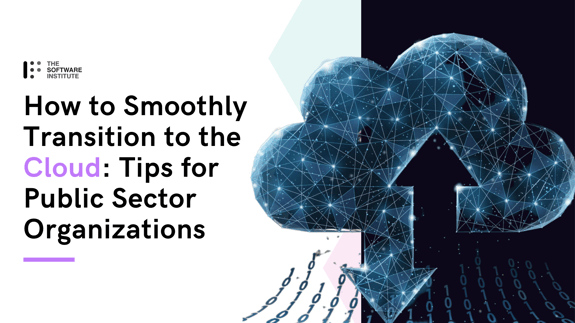Moving to the cloud can be a daunting task, particularly for organizations in the public sector. However, there are ways to make the transition smoother and more manageable. In this blog post, we’ll take a closer look at some of the challenges that organizations face when migrating to the cloud, and how they can overcome them.
Why the Public Sector Should Move to the Cloud
Public sector organisations all have their own unique sets of cloud drivers – local authorities want to enhance resident services, while healthcare organisations want to make it easy and safe for patients to engage with them. However, there are some cloud migration benefits that are universal.
Cost optimisation
Migrating to the cloud can be more cost-effective than the continued maintenance and management of a legacy on-premises infrastructure. Moreover, when evaluating an organisation’s current workloads, a cloud readiness assessment can help to evaluate workloads that are redundant and can be retired, ensuring more optimised costs in the future. This is essential for public sector organisations dealing with stretched budgets.
Remote collaboration and mobility
There’s no getting around it – hybrid working is here to stay. With hybrid working comes more complex user requirements and the need to provide ubiquitous experiences while ensuring performance, stability, and security always. Cloud migration makes this significantly more straightforward, as the latest cloud-native applications can be deployed and managed using the most appropriate delivery methods. So, wherever people are based, they can provide the best possible services to the citizens they support.
Enhanced cyber security and compliance
Recent reports from the National Cyber Security Centre (NCSC) have highlighted the cyber threat faced by the UK public sector. If implemented correctly, Cloud environments elevate organizations’ cyber security and compliance postures by meeting data protection, security and statutory requirements and storing valuable data and information in a central location. The major hyperscale cloud providers like Microsoft deliver robust cyber security capabilities throughout their public cloud platforms, and by partnering with a cloud specialist like The Software Institute, organizations can enhance this further through industry-leading consultancy.
Elasticity and scalability
With cloud, organizations only pay for the cloud resources that they use. This means that as organizations’ requirements evolve, they can alter resource requirements on-demand. As most cloud providers are on global platforms, organizations can enhance performance by running workloads closer to where users or customers are. This on-demand business model benefits future IT infrastructure and resource allocation and enables organizations to deploy applications quickly by adopting new technological capabilities, enabling organizations to meet their cloud drivers and enhance citizen services faster than ever before.
Backup, recovery, and failover
Cloud migration enables organizations to improve their disaster recovery and business continuity provisions by offering built-in, one-click backup and recovery capabilities. Rather than relying on secondary data centres connected through links that are often left redundant until called into use, cloud environments enable the deployment of sophisticated disaster recovery tools that can recover data and functionality in minutes – not hours or days. This is essential for public sector organizations who can face significant operational challenges and resultant fines for any downtime experienced.
Why is Cloud Migration Challenging in the Public Sector?
The public sector faces unique challenges when it comes to cloud migration. One of the biggest hurdles is compliance with regulations and policies that govern the handling of sensitive data. Government agencies and other public sector organizations must comply with a variety of regulations, such as the Health Insurance Portability and Accountability Act (HIPAA), the Federal Risk and Authorization Management Program (FedRAMP), and the General Data Protection Regulation (GDPR). These regulations are designed to protect sensitive data and ensure that it is handled securely.
Another challenge is the complexity of existing IT infrastructure. Many public sector organizations have legacy systems and applications that were developed years ago. These systems are often interdependent and require extensive testing and validation before they can be migrated to the cloud. This can be a time-consuming and expensive process, particularly for large organizations.
Finally, the public sector often has limited resources and budgets, which can make it difficult to hire the staff and acquire the tools necessary to support cloud migration.
How to Overcome These Challenges?
Despite the challenges, there are ways to make cloud migration more manageable for public sector organizations. Here are some tips:
Develop a Cloud Migration Strategy
A well-defined cloud migration strategy can help organizations prioritize their migration efforts and ensure that they comply with all necessary regulations and policies. The strategy should outline the goals of the migration, the scope of the project, the timeline, and the resources required to complete the project.
Choose the Right Cloud Provider
Not all cloud providers are created equal, particularly when it comes to compliance with regulations and policies. Public sector organizations should choose a cloud provider that has experience working with government agencies and can provide the necessary certifications and compliance frameworks.
Assess your Existing IT Infrastructure
Before migrating to the cloud, it is important to assess your existing IT infrastructure to identify any potential challenges or issues that may arise during the migration process. This can help organizations develop a migration plan that addresses these issues and minimizes the risk of downtime or data loss.
Use Automation and DevOps Practices
Automation and DevOps practices can help streamline the migration process and reduce the risk of errors. By automating tasks such as testing and deployment, organizations can speed up both the migration process and future releases. Ensuring that their systems are up and running as quickly as possible.
Identify Leaders & Train Your Staff
Finally, it is important to identify individuals who want to drive the cloud migration and train staff on cloud migration best practices and the use of new tools and technologies. This can help ensure that the migration process goes smoothly, and that staff are prepared to manage the new cloud environment.
----------------------------



COMMENTS